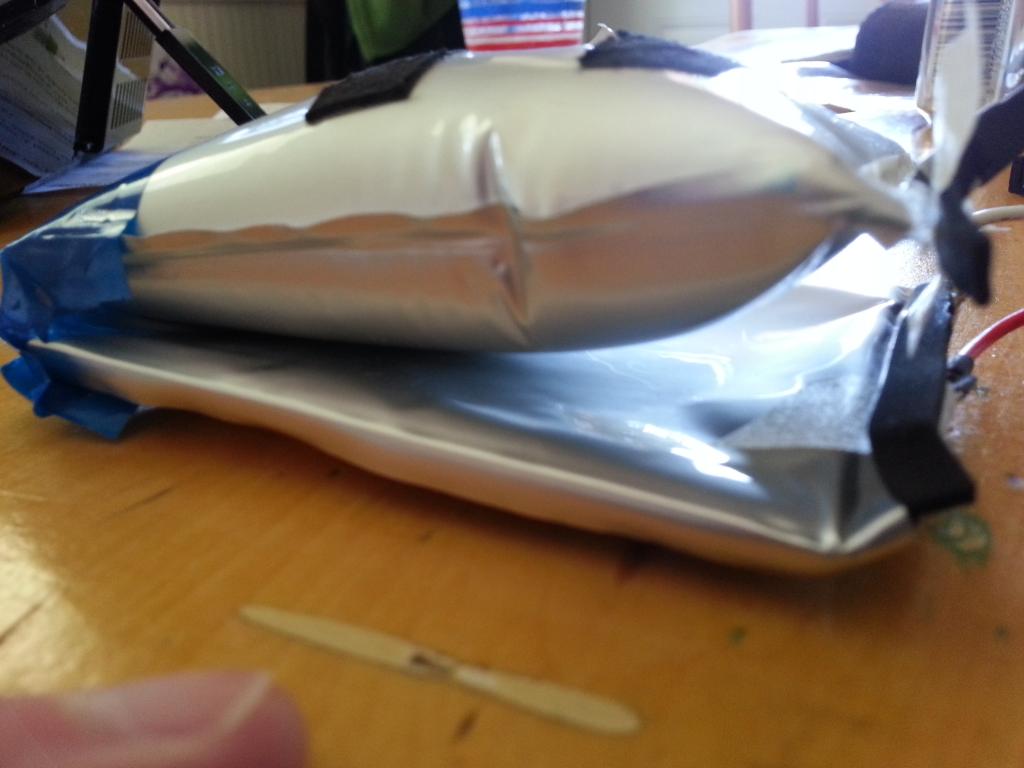Lithium polymer battery pack swelled inside portable tv
I have a Digital Labs 7" portable digital tv that I pretty much only use in the summer outside on the patio. Tonight I dug it out of the drawer after having been stored all winter and to my surprise the case was all swelled.


I took it apart and found that the Li-Po battery was all swelled. It cracked the LCD screen from the pressure. The power was in the off position and no it was not left plugged in to charge all winter. I'm wondering if there was a chance of fire or something else catastrophic? I removed the battery and the tv still comes on as you can see in the picture but now has a big void where it is cracked.
The battery pack consists of 2- 7.4 volt 2200mah batteries in series. There are 3 wires going to the charger circuitry so I'm guessing they tried to do some sort of balanced charging.
Too bad as it was a handy little tv...


I took it apart and found that the Li-Po battery was all swelled. It cracked the LCD screen from the pressure. The power was in the off position and no it was not left plugged in to charge all winter. I'm wondering if there was a chance of fire or something else catastrophic? I removed the battery and the tv still comes on as you can see in the picture but now has a big void where it is cracked.
The battery pack consists of 2- 7.4 volt 2200mah batteries in series. There are 3 wires going to the charger circuitry so I'm guessing they tried to do some sort of balanced charging.
Too bad as it was a handy little tv...


Comments
-Phil
Stuffed in drawers, attics, and in boxes in garages and basements.
All drawing down the charge separating two sides that vigorously want to meet.
silently... continuously... inevitably...
Boeing is once again having concerns about their use of lithium cells on their Dreamliners, so be conservative and safe.
The reality is that anything that increases energy density in any storage media comes with an increased hazard.
http://seattletimes.com/html/businesstechnology/2023671237_ntsbfaabatteriesxml.html
Disposal method....
http://konarcflyers.com/Lipo-Disposal.pdf
Rule of thumb: don't let people you value alive fly in 787 until the version AFTER the major incident. It will be a short wait.
which discharges them and prevents heat buildup and fire. Apparently after a few weeks they are then inert, but I
confess I don't know why that should be the case.
Swollen cells are damaged and dangerous and need attention.
LiPo cells should be stored in a fireproof location with about 50% charge I believe, and checked every so often.
http://news.yahoo.com/report-faa-too-reliant-boeing-battery-test-160413178--finance.html
PS: Yes, the Boeing 787 batteries are using the very same proven bad Lithium-Cobalt tech.
One can only wait for delivery and crack open the battery case to discover what has arrived.
++++++++++++++++
On the issue of these lithium soft packs...
I thought these were safer just because they swell without a hard containment. But I can't be sure that piercing any defective cell is a wise thing to do.
The idea of soaking the cell in salt water is rather simple chemistry. Salt water is an ionic solution, so it conducts electricity and will discharge the battery.
IF there is no dramatic chemical reaction between the salt and the existing electrolyte, it is a reasonable way to go. BUT, the way to avoid a dramatic chemical reaction is to fully and safely discharge the lithium cell BEFORE you pierce the package and soak in salt water. YOU CANNOT just immerse it in salt water and puncture... bad things might happen !!!!!!
See here
http://konarcflyers.com/Lipo-Disposal.pdf
for a link on how one fellow claims to do this all safely.
WHAT DO I THINK?
If you have a bloated lithium cell, it might be VERY WISE to do a controlled and complete discharge of the cell before passing it on to anyone for final disposal. The hazard is in the amount of stored energy that seems to have reached an unstable state.
It may or may not be necessary to go the extra steps to puncture the package and soak it in a salt brine. That does make a mess and adds all the containers and the brine solution to your disposal problem. Plus you expose yourself to chemical fumes and contamination. IOW, keep it simple and as safe as possible.
Would puncturing with a conductive material immediately start a run away thermal event or something?
The question I have is once the LIPOs are fully discharged are they then safe?
Tom
A chemist might give a long winded explanation about exo-thermic chemical reactions, the ability of lithium to burn in air, and other factors. But at the end of the day, it doesn't make sense for me to take on the responsiblity for becoming an amature chemist and breaking open batteries unless the circumstances are absolutely dire.
I found another link that actually says to first discharge the cell, disassemble the battery, make deep slashes in the fully discharged lithium cell, and then place in salt water. I feel that goes a step too far into dangerous territory.
My point is that the first option does nothing certain to remove the stored electricity in the cell; while the second option does too much when he gets involved in disassembly and slashing.
_______________
I think that discharging the cell slowly down to 0 volts it the best choice. Then maybe shorting the wires and marking the cell useless. I don't see why the cell that is fully discharged would be a fire hazard unless someone tries to recharge it. Plus, there is an advantage of keeping the sealed cell intact to avoid leaking chemicals or toxic fumes. And I don't see why one needs to make a chemical mess that needs more effort to properly dispose.
Forget the whole dunking in salt water proceedure. Just put a resistor load on the cell that will slowly bring down the voltage. Then submit the device to your friendly battery disposal authority for proper handling.
The internet has an answer for everything. Sadly, too many people write up stuff that might do more harm than good.
Here is a bit of history about why people fear a fireball from lithium batteries.
A. Lithium metal will burn in air
B. Early lithium batteries did produce flammable gases that would cause a dramatic failure. And even recent 'perfectly safe lithium cells' have caused fires.
http://www.avweb.com/blogs/insider/AVWebInsider_Batteries_206994-1.html
The problem is there are so many different lithium chemistries these days, the average user has no idea if he is using a safe or a dangerous one or if any are really safe.
Nonetheless, people are doing the salt water immersion. It is up to you to think it through if you do. That solution is no longer just salt water, it is a hazardous waste to be disposed of properly.
https://www.youtube.com/watch?v=gQ5PNG_niBs
Here is one video of how to set fire to one... via overcharging. The second video is an idiotic disassembly and immersion.
https://www.youtube.com/watch?v=B-AoAYrEy-o
https://www.youtube.com/watch?v=v7abq34mckg